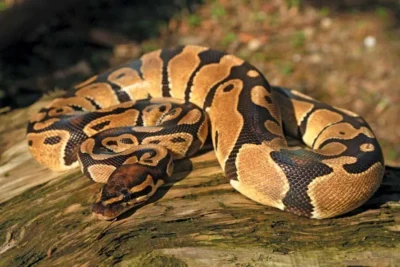Curiosity often leads us to ponder the seemingly mundane aspects of caring for our beloved pets. Among these questions, one that frequently arises among ball python owners is, How often do ball pythons poop?
Ball pythons typically poop about once every 1-2 weeks, although individual variations can occur based on factors like age, diet, and environmental conditions. Younger pythons tend to defecate more frequently, sometimes every 4-7 days, while older individuals may go longer between bowel movements.
Additionally, changes in diet or stress levels can also affect the frequency of bowel movements in ball pythons. Monitoring your snake’s bathroom habits is essential for gauging its health and ensuring it receives proper care.
How often do ball pythons poop?

Ball pythons typically poop about once every 1-2 weeks, although the frequency can vary depending on factors such as age, size, and feeding schedule. The digestion process in snakes is relatively slow compared to mammals, primarily due to their ectothermic nature (relying on external heat sources to regulate their body temperature), so they don’t need to eliminate waste as frequently.
After consuming a meal, a ball python’s digestive system goes to work breaking down the food. This process can take several days to a week or more, depending on the size and composition of the meal. Once the food has been fully digested and the nutrients absorbed, the remaining waste is expelled as feces.
Factors that can influence the frequency of defecation include the size of the meal, ambient temperature, and individual metabolism. Additionally, ball pythons may hold onto waste if they are stressed or if environmental conditions are not ideal for digestion.
Regular monitoring of a ball python’s feeding and bathroom habits is essential for ensuring their health and well-being. Any significant changes in these patterns may indicate underlying health issues and should be addressed promptly by a veterinarian familiar with reptiles.
Normal Ball Python Defecation Frequency
A healthy adult ball python typically defecates about once every 1-2 weeks. However, this frequency can vary based on factors such as age, size, metabolism, and feeding schedule. Younger snakes may defecate more frequently, sometimes after each meal, while older individuals may have longer intervals between bowel movements.
It’s essential for ball python owners to monitor their snake’s defecation patterns and keep track of when they last eliminated waste. Any significant deviations from their normal schedule could indicate potential health issues, such as digestive problems or parasites.
Ensuring that your ball python has the appropriate temperature gradients, humidity levels, and a proper diet can help maintain regular bowel movements and overall health. If you notice any abnormalities in your snake’s defecation habits or appearance, consulting a reptile veterinarian is recommended for further evaluation and appropriate treatment.
Factors influencing bal python defecation frequency
Several factors can influence the defecation frequency of ball pythons:
- Age and Size: Younger ball pythons tend to have faster metabolisms and may defecate more frequently, whereas older snakes may have longer intervals between bowel movements. Similarly, larger snakes may take longer to digest their food compared to smaller ones.
- Feeding Schedule: The frequency of defecation is closely tied to the feeding schedule. Ball pythons typically defecate after digesting a meal, so the timing and size of their meals can affect how often they eliminate waste.
- Diet Composition: The type and size of prey consumed can influence digestion and defecation. Larger or harder-to-digest prey items may take longer to pass through the digestive system, resulting in less frequent bowel movements.
- Temperature and Environment: Ball pythons are ectothermic, meaning they rely on external heat sources to regulate their body temperature and metabolism. Optimal temperature gradients and humidity levels are essential for proper digestion. Environmental factors that are too cold or too dry can slow down digestion and potentially prolong the time between bowel movements.
- Hydration: Adequate hydration is crucial for healthy digestion. If a ball python is dehydrated, it may experience constipation, leading to infrequent or difficult bowel movements.
- Stress: Stress can disrupt normal bodily functions, including digestion. Changes in the environment, handling, or the presence of other animals can stress out a ball python, potentially affecting its defecation frequency.
- Health Status: Underlying health issues such as infections, parasites, or gastrointestinal blockages can affect a ball python’s digestion and defecation. Any changes in defecation frequency, consistency, or appearance should be promptly addressed by a reptile veterinarian.
By considering these factors and providing proper care and husbandry, ball python owners can help maintain regular defecation patterns and ensure the overall health and well-being of their snakes.
Signs of Impending Defecation for ball python
Ball pythons, like many snakes, may exhibit certain behaviors or physical signs indicating that they are preparing to defecate. While individual snakes may vary in their specific behaviors, some common signs of impending defecation in ball pythons include:
- Restlessness: A ball python may become more active or restless than usual as it prepares to defecate. It may explore its enclosure more, move around frequently, or seem unsettled.
- Seeking a Hiding Spot: Before defecating, a ball python might seek out a hiding spot or retreat to its hide box. This behavior is natural for many snakes, as they prefer privacy when eliminating waste.
- Repeatedly Rubbing Against Surfaces: Some ball pythons may rub their vent area against surfaces in their enclosure or substrate. This behavior may help stimulate the muscles involved in defecation.
- Body Postures: A ball python may assume certain body postures or positions that suggest it is preparing to defecate. This can include lifting its tail, arching its back, or adopting a tense or focused stance.
- Reduced Appetite: In some cases, a ball python may exhibit a decreased appetite leading up to defecation. This reduction in feeding behavior is temporary and typically resolves after the snake has eliminated waste.
- Visible Swelling or Bulge: As waste accumulates in the snake’s digestive tract, you may notice a visible swelling or bulge in the lower portion of its body. This bulge may become more prominent as defecation approaches.
- Increased Fecal Odor: Before defecating, the feces inside a ball python’s digestive tract may begin to emit a stronger odor. This can sometimes be detected when cleaning the enclosure or handling the snake.
It’s essential for ball python owners to familiarize themselves with their snake’s typical behaviors and habits to recognize any deviations that may indicate impending defecation or other health concerns. Providing a suitable environment with appropriate temperature, humidity, and hiding places can help ensure that your ball python feels comfortable and secure when it needs to eliminate waste.
Monitoring and Managing ball python Bowel Movements


